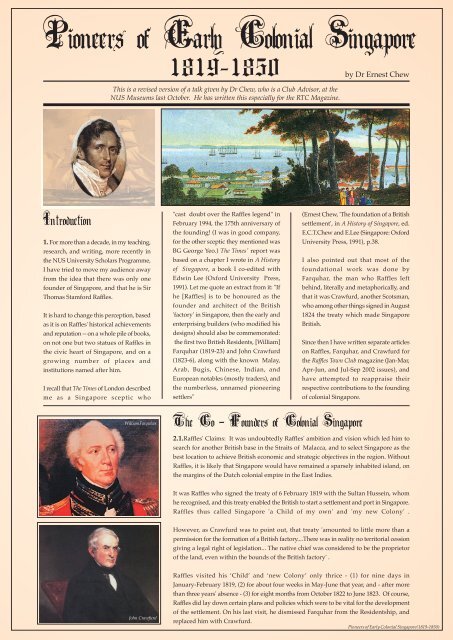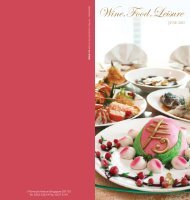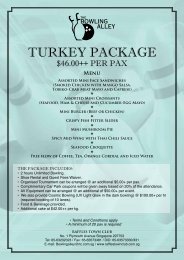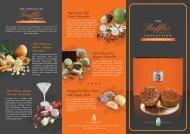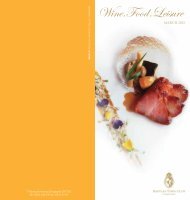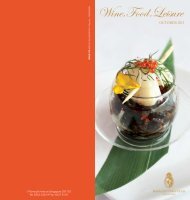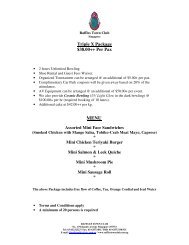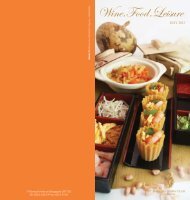Pioneers of Early Colonial Singapore(1819- 1850)
Pioneers of Early Colonial Singapore(1819- 1850)
Pioneers of Early Colonial Singapore(1819- 1850)
You also want an ePaper? Increase the reach of your titles
YUMPU automatically turns print PDFs into web optimized ePapers that Google loves.
<strong>Pioneers</strong> <strong>of</strong> <strong>Early</strong> <strong>Colonial</strong> <strong>Singapore</strong>(1<strong>1850</strong>)<strong>1819</strong>-<strong>1850</strong>by Dr Ernest ChewThis is a revised version <strong>of</strong> a talk given by Dr Chew, who is a Club Advisor, at theNUS Museums last October. He has written this especially for the RTC Magazine.Introduction1. For more than a decade, in my teaching,research, and writing, more recently inthe NUS University Scholars Programme,I have tried to move my audience awayfrom the idea that there was only onefounder <strong>of</strong> <strong>Singapore</strong>, and that he is SirThomas Stamford Raffles.It is hard to change this perception, basedas it is on Raffles' historical achievementsand reputation -- on a whole pile <strong>of</strong> books,on not one but two statues <strong>of</strong> Raffles inthe civic heart <strong>of</strong> <strong>Singapore</strong>, and on agrowing number <strong>of</strong> places andinstitutions named after him.I recall that The Times <strong>of</strong> London describedme as a <strong>Singapore</strong> sceptic whoWilliamFarquhar"cast doubt over the Raffles legend" in (Ernest Chew, 'The foundation <strong>of</strong> a BritishFebruary 1994, the 175th anniversary <strong>of</strong> settlement', in A History <strong>of</strong> <strong>Singapore</strong>, ed.the founding! (I was in good company, E.C.T.Chew and E.Lee (<strong>Singapore</strong>: Oxfordfor the other sceptic they mentioned was University Press, 1991), p.38.BG George Yeo.) The Times' report wasbased on a chapter I wrote in A History I also pointed out that most <strong>of</strong> the<strong>of</strong> <strong>Singapore</strong>, a book I co-edited with foundational work was done byEdwin Lee (Oxford University Press, Farquhar, the man who Raffles left1991). Let me quote an extract from it: "If behind, literally and metaphorically, andhe [Raffles] is to be honoured as the that it was Crawfurd, another Scotsman,founder and architect <strong>of</strong> the British who among other things signed in August'factory' in <strong>Singapore</strong>, then the early and 1824 the treaty which made <strong>Singapore</strong>enterprising builders (who modified his British.designs) should also be commemorated:the first two British Residents, [William] Since then I have written separate articlesFarquhar (<strong>1819</strong>-23) and John Crawfurd on Raffles, Farquhar, and Crawfurd for(1823-6), along with the known Malay, the Raffles Town Club magazine (Jan-Mar,Arab, Bugis, Chinese, Indian, and Apr-Jun, and Jul-Sep 2002 issues), andEuropean notables (mostly traders), and have attempted to reappraise theirthe numberless, unnamed pioneering respective contributions to the foundingsettlers"<strong>of</strong> colonial <strong>Singapore</strong>.The Co - Founders <strong>of</strong> <strong>Colonial</strong> <strong>Singapore</strong>?2.1.Raffles' Claims: It was undoubtedly Raffles' ambition and vision which led him tosearch for another British base in the Straits <strong>of</strong> Malacca, and to select <strong>Singapore</strong> as thebest location to achieve British economic and strategic objectives in the region. WithoutRaffles, it is likely that <strong>Singapore</strong> would have remained a sparsely inhabited island, onthe margins <strong>of</strong> the Dutch colonial empire in the East Indies.It was Raffles who signed the treaty <strong>of</strong> 6 February <strong>1819</strong> with the Sultan Hussein, whomhe recognised, and this treaty enabled the British to start a settlement and port in <strong>Singapore</strong>.Raffles thus called <strong>Singapore</strong> 'a Child <strong>of</strong> my own' and 'my new Colony' .However, as Crawfurd was to point out, that treaty 'amounted to little more than apermission for the formation <strong>of</strong> a British factory....There was in reality no territorial cessiongiving a legal right <strong>of</strong> legislation... The native chief was considered to be the proprietor<strong>of</strong> the land, even within the bounds <strong>of</strong> the British factory' .Tan Tock SengJohn CrawfurdRaffles visited his ‘Child’ and ‘new Colony’ only thrice - (1) for nine days inJanuary-February <strong>1819</strong>, (2) for about four weeks in May-June that year, and - after morethan three years' absence - (3) for eight months from October 1822 to June 1823. Of course,Raffles did lay down certain plans and policies which were to be vital for the development<strong>of</strong> the settlement. On his last visit, he dismissed Farquhar from the Residentship, andreplaced him with Crawfurd.<strong>Pioneers</strong> <strong>of</strong> <strong>Early</strong> <strong>Colonial</strong> <strong>Singapore</strong>(<strong>1819</strong>-<strong>1850</strong>)
9-2.2.Farquhar's Counter-Claims, alongsideRaffles and Crawfurd, are well summedup by Dr C. Mary Turnbull: "<strong>Singapore</strong>was fortunate in her three early pioneeradministrators: Raffles, a man <strong>of</strong>extraordinary vision, but for whom<strong>Singapore</strong> would never have existed;Farquhar, who by his energy, good senseand courage, nursed the infant settlementthrough its first dangerous years; andCrawfurd, shrewd and sensible, with hisfeet planted firmly on the ground, whoconverted into reality Raffles' mostpractical dreams" (A History <strong>of</strong> <strong>Singapore</strong><strong>1819</strong>-1988 (<strong>Singapore</strong>: OUP, 1989), p.30).Farquhar was a pretty tough 'nurse'. Hewas both British Resident andCommandant (a post which hepreviously held in Malacca), and helpedto secure the settlement against attacksfrom the irate Dutch authorities. Throughhis connexions with the Malay rajas, andwith Malacca,he attracted many tradersfrom the peninsula and archipelago to<strong>Singapore</strong>. He had to administer thesettlement with little help from Raffles,who was stationed in Bencoolen in westSumatra.When Farquhar finally left <strong>Singapore</strong> atthe end <strong>of</strong> 1823, he was given a granderfarewell from the local community thanRaffles had received in June. No wonderhe was upset when Raffles and later LadyRaffles emphasised Raffles' solo role as"founder". Farquhar registered his ownclaim for some recognition, and when hedied in 1839, the inscription on his tombin Perth, Scotland, stated that he"founded" the settlement <strong>of</strong> <strong>Singapore</strong>!I think it a real pity that there is so littlerecognition <strong>of</strong> Farquhar in present-day<strong>Singapore</strong>. The only road named afterhim, Farquhar Street, was erased in theearly 1990s.Even the exhibition <strong>of</strong> the Farquharcollection <strong>of</strong> natural history drawings issuspended, since the main <strong>Singapore</strong>History Museum is closed for redevelopment.2.3.Crawfurd's Contributions: I do notconsider Dr John Crawfurd as a c<strong>of</strong>ounderto the same extent as Raffles andFarquhar. He did not become Residentuntil May-June 1823, four years after theBritish settlement had been established.Yet, when we consider the idea <strong>of</strong> aBritish colonial settlement, we cannotescape the fact that it was only the Anglo-Malay Treaty <strong>of</strong> August 1824, whichCrawfurd concluded with the Malayrajas, which made <strong>Singapore</strong> a Britishpossession. This treaty followed theAnglo-Dutch Treaty <strong>of</strong> London, in March1824, by which the Dutch recognised that<strong>Singapore</strong> and the Malay States were inthe British sphere <strong>of</strong> political influence.It was also the Anglo-Dutch treatywhich led to the exchange <strong>of</strong> DutchMalacca for British Bencoolen.2.4.Others? The work <strong>of</strong> founding orestablishing colonial <strong>Singapore</strong> was notaccomplished by one, two or threepersons, but was the collaborative effort<strong>of</strong> other <strong>of</strong>ficial and non-<strong>of</strong>ficial pioneers.It was the joint success <strong>of</strong> all theirendeavours which lent lustre to the nameand reputation <strong>of</strong> Raffles.Dr K.G. Tregonning puts this succinctly:"<strong>Singapore</strong> remained British, in the finaloutcome, because unlike the othersettlements initiated by Raffles, it wasfound worth keeping; it saved itself byits own exertions. ... "Raffles paid onlythree brief visits to <strong>Singapore</strong>.He played no part whatever in itsretention, hardly any in its development.Historians have long claimed for Rafflesall the subsequent growth <strong>of</strong> thesettlement. His master touch has beeneverywhere. In fact, the credit for<strong>Singapore</strong>'s growth must go to those whomade it grow, to the people who indefiance <strong>of</strong> all history built a bustling porton the equator" (The British in Malaya(Tucson: University <strong>of</strong> Arizona Press,1965), pp.153,160.) In other words, it wasnot so much Raffles who made <strong>Singapore</strong>,but <strong>Singapore</strong> which made Raffles!The Constructionand the <strong>Early</strong> BuildersIt is difficult to make a clear-cut distinctionbetween founders and builders <strong>of</strong> earlycolonial <strong>Singapore</strong>. If "founding" isequated with "establishment", and takento be a process rather than an initial act,then we can regard the earliest leaders <strong>of</strong>the various communities in <strong>Singapore</strong> tohave been co-founders as well as earlybuilders <strong>of</strong> the settlement . Certainly wecan consider all <strong>of</strong> them as ‘pioneers’.3.1.The Malay Rajas:Moving away from the British triad <strong>of</strong> c<strong>of</strong>ounders-- Raffles, Farquhar, Crawfurd -- we must start with the Malay rajas -(1) Sultan Hussein, who with his followersoccupied the Kampong Glam area; and(2) Temenggong Abdu'r Rahman, whowith his followers lived along the<strong>Singapore</strong> River and then movedwestwards to Telok Blangah.While <strong>Singapore</strong> became increasinglycosmopolitan as a commercial centre, theMalays still constituted about 60% <strong>of</strong> thepopulation in 1821 (3,000 out <strong>of</strong> 5,000), inwhat was still an Anglo-Malaycondominium, until 1824.A Quarterly Publication <strong>of</strong> Raffles Town Club 11<strong>Pioneers</strong> <strong>of</strong> <strong>Early</strong> <strong>Colonial</strong> <strong>Singapore</strong>(<strong>1819</strong>-<strong>1850</strong>)
The Sultan’s and Temenggong's networks,as well as Farquhar’s links with Malacca,led to this influx and growth.3.2.The Straits and Nanyang Chinese:The earliest Chinese builders <strong>of</strong> thesettlement came from the immediatevicinity, from the Malay Peninsula andArchipelago, from places like Malacca,Penang, and Riau, and the majority werefrom settled Baba families.According to Dr Turnbull, "The mostimportant <strong>of</strong> <strong>Singapore</strong>'s Chinesepioneers was Tan Che Sang, who left hisnative Canton in 1778 at the age <strong>of</strong> 15,and after making his fortune in Riau,Penang, and Malacca, came to <strong>Singapore</strong>in <strong>1819</strong>, where he built the first warehouseand was agent for the early Chinesejunks." However, she adds that "he hadno social contact with the rulingcommunity and was a strange withdrawnman, an inveterate gambler, obsessedwith making money..." (Turnbull, p.13).She contrasts him with the youngerHokkien leader, Chua Chong Long, son<strong>of</strong> the Kapitan China <strong>of</strong> Malacca, "anopen-handed extrovert" who "entertainedEuropeans to lavish entertainments, andwas the government's most trusted gobetweenwith the Chinese communityuntil he left <strong>Singapore</strong> in 1836" (p.14).Among others who came from the Babacommunity in Malacca was Tan TockSeng, who came to <strong>Singapore</strong> as avegetable hawker in <strong>1819</strong>, when he was21, and rose to be a rich merchantand philanthropist, being the founder <strong>of</strong>a pauper hospital at Pearl's Hill in 1844In which later became "TTSH" (pp.14,62-3). Another Hokkien Baba who came fromMalacca was Tan Kim Seng, who alsobecame a rich merchant, and was the firstAsian Justice <strong>of</strong> the Peace.However, the early Straits Chinesedominance gave way to that <strong>of</strong> Chinabornimmigrant traders like the Teochewleader, Seah Eu Chin, and the more wellknownCantonese leader, Hoo Ah Kay,known as Whampoa from his birth-placein Guangdong province. They botharrived here in 1830. Whampoa was tobe the first Chinese and Asian member<strong>of</strong> the Legislative and later ExecutiveCouncil <strong>of</strong> the Straits Settlements in the1860s and 1870s (p.54).Tan Tock SengBy 1840 the Chinese comprised about50% <strong>of</strong> the population <strong>of</strong> <strong>Singapore</strong>. (Formore details on the Chinese, see SongOng Siang, One Hundred Years' History <strong>of</strong>the Chinese in <strong>Singapore</strong> (1923; reprint,<strong>Singapore</strong>: University <strong>of</strong> Malaya Press,1967.)3.3.The Bugis:Next to the Chinese, the largest group <strong>of</strong>early immigrants was the Bugis who tookrefuge here in 1820, from the Dutch inRiau, under their leader, Arong Bilawa.They made <strong>Singapore</strong> a Bugis junction!3.4.The Indians:While most Indians in early colonial<strong>Singapore</strong> were sepoys and campfollowers in the cantonments, there werealso merchants, the most famous <strong>of</strong>whom was Naraina Pillai, who came herefrom Penang with Raffles on his secondvisit in May <strong>1819</strong>. He was a literal"builder" <strong>of</strong> early colonial <strong>Singapore</strong>, forhe started a brick-kiln, and was the firstbuilding contractor -- and he also openeda shop selling cotton piece-goods. Hebecame bankrupt when the shop burneddown in 1822, but Raffles helped him tore-start his business, which was toprosper greatly.3.5.The Arabs, Armenians, Jews andAmericans: With his background asformer Lieutenant-Governor <strong>of</strong> Java,Raffles sought to attract enterprising Arabtraders from the Dutch East Indies. Thefirst to arrive in <strong>1819</strong>, from Palembangin Sumatra, were Syed Mohammed binHarun Al-Junied and his nephew SyedOmar bin Ali Al-Junied. They settled inKampong Glam,and built a thrivingcommunity around Arab Street.A smaller but also rich tradingcommunity were the Armenians, ledinitially by Aristarchus Moses whoarrived in 1820. They built one <strong>of</strong> thefirst Christian churches in <strong>Singapore</strong>, theArmenian Church <strong>of</strong> St.Gregory,consecrated in 1836.The earliest Jewish traders had arrivedby 1830. The pioneer was a man withthe impressive name <strong>of</strong> AbrahamSolomon, who came from Baghdad. Helived in Boat Quay, and later built thefirst Jewish synagogue in the early 1840s.3.6.The Europeans: In the social peckingorder,the most influential traders were<strong>of</strong> course the Europeans, and the mostinfluential among them were the Scots.Again, I take my cue from Dr MaryTurnbull who writes: "Most <strong>of</strong> the earliestEuropeans were former merchant navymen or agents <strong>of</strong> Calcutta firms.The doyen <strong>of</strong> the mercantile communitywas a Scotsman, Alexander LaurieJohnston, a former ship's owner/captain,who settled in July 1820, founded thefirm <strong>of</strong> A.L. Johnston & Company, andremained the leader <strong>of</strong> the Europeanmerchants until his retirement from theEast in 1841. Another Scot, AlexanderGuthrie, founder <strong>of</strong> <strong>Singapore</strong>'s oldestsurviving firm, arrived from the Cape <strong>of</strong>Good Hope in January 1821" (Turnbull,p.15).This theme is taken up by Mr RoderickMacLean, in his c<strong>of</strong>fee-table book, APattern <strong>of</strong> Change: the <strong>Singapore</strong> InternationalChamber <strong>of</strong> Commerce from 1837(<strong>Singapore</strong>: SICC, 2000): "In the earliestdays <strong>of</strong> the settlement, the number <strong>of</strong>European firms based in <strong>Singapore</strong> wasnaturally quite small.... There was a strongScottish contingent among them, whichin other, less politically correct, days mightalmost have been termed a Scottish,'Mafia' with apparent nepotictendencies..." (p.17).Maclean also notes the influence <strong>of</strong> thetrading community in local affairs:"Inevitably in such a small community,the leading figures, the majority <strong>of</strong> whomwere merchants, involved themselvesin every cause and issue <strong>of</strong> the day, bothgreat and small" (p.18).He also highlights the role <strong>of</strong> Scotsmenin the founding <strong>of</strong> the <strong>Singapore</strong>Chamber <strong>of</strong> Commerce. AlexanderJohnston was the founding Chairman in1837, and Alexander Guthrie waschairman in 1846 and 1847 (pp.22-25).Apart from the first two British Residents,most <strong>of</strong> the magistrates (who were mostlymerchants) appointed by Raffles werealso Scotsmen. [For details on all thesetraders, see C.B.Buckley, An AnecdotalHistory <strong>of</strong> Old Times in <strong>Singapore</strong> (1902;reprint, Kuala Lumpur: University <strong>of</strong>Malaya Press, 1965).]Among the earliest Americans to arrive 4. Concluding Businessin <strong>Singapore</strong> was Joseph Balestier, who Lest it be thought that I have given unduebecame the first American Consul here. prominence to the role <strong>of</strong> these traders asHis wife, Maria, was a daughter <strong>of</strong> the pioneers <strong>of</strong> early colonial <strong>Singapore</strong>, letfamed American patriot, Paul Revere, me remind you <strong>of</strong> a famous statement <strong>of</strong>and presented a bell for St. Andrew’s one <strong>of</strong> the less famous AmericanChurch. This Revere Bell was later Presidents, Calvin Coolidge, who saiddonated to the Museum and even later that "The chief business <strong>of</strong> the Americanloaned to the U.S. Embassy.people is business". I think it couldalso be said that "The chief business <strong>of</strong>the <strong>Singapore</strong>an people is business". Itwas so in the early days, and it remainstrue today.A Quarterly Publication <strong>of</strong> Raffles Town Club 11<strong>Pioneers</strong> <strong>of</strong> <strong>Early</strong> <strong>Colonial</strong> <strong>Singapore</strong>(<strong>1819</strong>-<strong>1850</strong>)[Dr Ernest Chew is an Associate Pr<strong>of</strong>essorial Fellow <strong>of</strong> the UniversityScholars Programme at the National University <strong>of</strong> <strong>Singapore</strong>, and HonoraryChairman <strong>of</strong> the <strong>Singapore</strong> History Museum]


